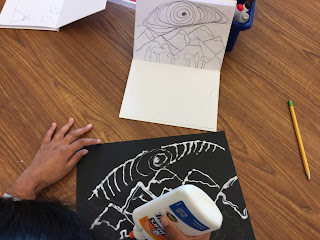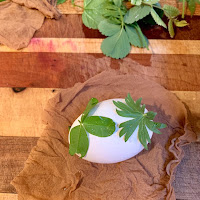Transitional Kindergarten: Snowflake prints
TK students experimented creating snowflakes using a tissue paper bleeding technique. Students used cool colored tissue paper, torn or cut into thin strips. Students layered their tissue paper strips in a crisscross star design and used a brush with water to paint over their snowflakes. By washing over the tissue paper it sticks down and creates beautiful color bleeds and washes onto the background paper.
To create an additional, layered effect, students used scratch foam to create a printing plate (stamp) of a snow flake. Students used brayers to roll blue printing ink onto their printing plates and printed their snowflakes onto their previously designed backgrounds.
Kindergarten: Bird House Prints
Kindergarten students were inspired by the thousands of bird houses Bill Larkin also know as "Crazy Bill" has built and is still continuing to build. He paints them in brilliant bright colors and adds lovely decor and details.
Bill's yard is filled with the sounds of fluttering wings and contented chirps. He said he plans to keep building and painting birdhouses even though he's run out of room; now he erects them across the street and deeper into the woods.
Visitors love to stop by and enjoy the colorful display. If they inquire about purchasing a bird house Bill will tell them they are for free. He just loves creating the bird houses and making people happy.
Kindergarten students created a practice sketch of their bird houses. Students used scratch foam to carve a printing plate of their drawing and used printers ink to make a print. Students used white oil pastels to draw snow flakes, stars, and other designs to decorate a frame around their lovely bird house prints.
1st GRADE: Polar Bear Portraits
To start this lesson we did a read aloud of the book: White Bear, Ice Bear by Janne Ryder. We also researched some polar bear facts, and found out that polar bears have black skin, and a group of polar bears is called a celebration!
Using white chalk on black construction paper students sketched a polar bear portrait. Students used the sides of white chalk to rub a round shape for the head and a body. Two smaller circles made the ears. Students used their fingers to gently blend the chalk to remove any harsh lines that may have been created. Black oil pastels were used to create the facial features and the inner ears. Students rubbed a little bit with the black pastel under the head to create a bit of a shadow. Then they cut our the whole polar bear shape. With a tear and paste technique students created a background with icebergs. The final display turned out to be adorable. A celebration of polar bears!
To start this lesson we did a read aloud of the book: White Bear, Ice Bear by Janne Ryder. We also researched some polar bear facts, and found out that polar bears have black skin, and a group of polar bears is called a celebration!
Using white chalk on black construction paper students sketched a polar bear portrait. Students used the sides of white chalk to rub a round shape for the head and a body. Two smaller circles made the ears. Students used their fingers to gently blend the chalk to remove any harsh lines that may have been created. Black oil pastels were used to create the facial features and the inner ears. Students rubbed a little bit with the black pastel under the head to create a bit of a shadow. Then they cut our the whole polar bear shape. With a tear and paste technique students created a background with icebergs. The final display turned out to be adorable. A celebration of polar bears!
2nd GRADE: Warm/Cool Color Imaginary Landscape
Second grade students continued their studies of color theory working with the color schema warm and cool. With colors an artist can set a mood, attract attention, or make a statement. Color can be used to energize, or to calm down. By selecting a color scheme, artists can create an ambiance of elegance, warmth or tranquility, or convey an image of playful youthfulness. Color can be an artist's most powerful design element if learned to use effectively.
Colors affect us in numerous ways, both mentally and physically. A strong red color has been shown to raise blood pressure, while a blue color has a calming effect.
Students learned to use colors consciously and harmoniously to create spectacular results.
Students sketched imaginary, landscape compositions and used a glue and oil pastel/baby oil wash technique to carefully color their landscape compositions with warm/cool color combinations.
Colors affect us in numerous ways, both mentally and physically. A strong red color has been shown to raise blood pressure, while a blue color has a calming effect.
Students learned to use colors consciously and harmoniously to create spectacular results.
Students sketched imaginary, landscape compositions and used a glue and oil pastel/baby oil wash technique to carefully color their landscape compositions with warm/cool color combinations.
3rd Grade: Chinese Chop Seal
Third grade students continued their practice using sumi-e ink and Chinese brushes to depict traditional imagery from Asian cultures. The final paintings were painted on rice paper and students created a “seal/chop” to print onto their finished ink painting piece.
A Chinese seal or chop is a stamp containing Chinese characters used in East Asia to prove identity on documents, contracts, art, or similar items of importance.
Chinese chops, or seals are used to inscribe a person's name or family name onto items such as government documents, art, and literary works. Used since the shang dynasty (s600-1046 BCE), Chinese chops were also seen as works of art.
The original use of Chines chops may have been to help those who could not read easily identify certain characters on official government documents or even to make the documents appear official. Whether it was the emperor who could not read or write, or the people of the emperor's empire, using a chop to make a mark on a piece of paper helped everyone understand more about what they were being told.
Since ancient times, artists sing their paintings with their chop. So did our 3rd grade students. In China, people who buy paintings often add their own chop. Some paintings from Ancient China have over 20 chop marks. The marks do not take away value from the painting but can actually increase the price depending on who purchased the parting over the years.
A Chinese seal or chop is a stamp containing Chinese characters used in East Asia to prove identity on documents, contracts, art, or similar items of importance.
Chinese chops, or seals are used to inscribe a person's name or family name onto items such as government documents, art, and literary works. Used since the shang dynasty (s600-1046 BCE), Chinese chops were also seen as works of art.
The original use of Chines chops may have been to help those who could not read easily identify certain characters on official government documents or even to make the documents appear official. Whether it was the emperor who could not read or write, or the people of the emperor's empire, using a chop to make a mark on a piece of paper helped everyone understand more about what they were being told.
Since ancient times, artists sing their paintings with their chop. So did our 3rd grade students. In China, people who buy paintings often add their own chop. Some paintings from Ancient China have over 20 chop marks. The marks do not take away value from the painting but can actually increase the price depending on who purchased the parting over the years.
4th GRADE: Robotic Bugs (STEAM)
Fourth grade students where guided in a unique arts integration opportunity to design and create three-dimensional robotic bugs. Students built a simple electric circuit with a motor to engineer a working model of a simple robotic critter. Students worked through the challenges in altering the simple plain looking design they started with and made a working plan. Through lots of experimentation and alteration students designed and built artistic, and unique looking bugs.
At the end of this unit of study students had the opportunity to reflect upon their design process. Students reflected upon their process in verbal and written form. Students described challenging parts, enjoyable parts, and highlighted some changes they made to their structures/designs.
At the end of this unit of study students had the opportunity to reflect upon their design process. Students reflected upon their process in verbal and written form. Students described challenging parts, enjoyable parts, and highlighted some changes they made to their structures/designs.







































































